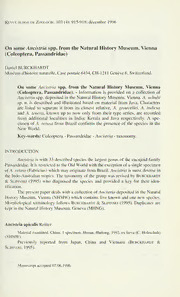
On some Ancistria spp. from the Natural History Museum, Vienna (Coleoptera, Passandridae) PDF
Preview On some Ancistria spp. from the Natural History Museum, Vienna (Coleoptera, Passandridae)
Revue suisse deZoologie, 103 (4): 915-918; décembre 1996 On someAncistria spp. from the Natural History Museum, Vienna (Coleoptera, Passandridae) BURCKHARDT Daniel Muséum d'histoire naturelle, Case postale 6434, CH-1211 Genève 6, Switzerland. On some Ancistria spp. from the Natural History Museum, Vienna (Coleoptera, Passandridae). - Information is provided on a collection of Ancistria spp. deposited in the Natural History Museum, Vienna. A. schuhi sp. n. is described and illustrated based on material from Java. Characters are listed to separate it from its closest relative, A. grouvellei. A. indicus and A. tenera, known up to now only from their type series, are recorded from additional localities in India: Kerala and Java respectively. A spe- cimen ofA. retusa from Brazil confirms the presence of the species in the New World. Key-words: Coleoptera - Passandridae -Ancistria - taxonomy. INTRODUCTION Ancistria is with 33 described species the largest genus of the cucujoid family Passandridae. It is restricted to the Old World with the exception ofa single specimen ofA. retusa (Fabricius) which may originate from Brazil. Ancistria is most diverse in the Indo-Australian tropics. The taxonomy of the group was revised by Burckhardt & Slipinski (1995) who diagnosed the species and provided a key for their iden- tification. The present paper deals with a collection ofAncistria deposited in the Natural History Museum, Vienna (NHMW) which contains five known and one new species. Morphological terminology follows Burckhardt & Slipinski (1995). Duplicates are keptin the Natural History Museum, Geneva (MHNG). Ancistria apicalis Reitter Material examined. China: 1 specimen, Hunan, Huitong, 1992, ex larva (C. Holzschuh) (NHMW). Previously reported from Japan, China and Vietnam (Burckhardt & Slipinski, 1995). Manuscriptaccepted07.06.1996. 916 DANIELBURCKHARDT Ancistria beccarii Grouvelle W SE SulaMwaetseir,iaKlenedxaarmiineAidr.poIrntd,on3e0siak:m1WspeocfimKeenn,dari,Su1m1a-t1r4a.,11.11999924((NMH.MSWt)rb;a 1&spI.ecJiemneins), (NHMW). Previously reported from New Guinea, Moluccas and Malaysia (Burckhardt & Slipinski, 1995). Ancistria indica Burckhardt & Slipinski Material examined. India: 2 specimens, Kerala, Cardamom Hills, 10 km SW Munnar Vattiar, 1000m, 6-18.XII.1993 (Boukal & Kejval) (NHMW). Previously known only from the type series which was reported with some doubt from India: Tamil Nadu. The new material confirms the occurrence of the species in Southern India. Ancistria retusa (Fabricius) So, 14MaktmeriSalWeBxaamoinLeodc., T1a6i-w2a9n.:V.119â9,4F(oPramcohsoal,atFkuoho&shDoem(bSaiuctkeyr))((NNHHMMWW))..SInVdioentensaiam:: 65 S S, 3 9 2, SE Sulawesi, Buton Island. Warkarumba, 3-7.II.1994 (M. Strba & I. Jenis) (NHMW, MHNG). Brazil: 1 3, without additionaldata(NHMW). Reported from Africa. Tropical Asia. Australia and questionably from Brazil (Burckhardt & Slipinski, 1995). The specimen from Brazil from the NHMW confirms the occurrence ofthe species in the New World. Ancistria schuhi sp. n. (Figs 1-7) W Material examined: Holotype 9 Indonesia: Java, Puncak Pass, SE Bogor, Telaga . Warna, ca. 1400 m, 1.Vili.1994 (R. Schuh) (NHMW). Paratype: 1 9, same data as holotype but(MHNG). Description. Length 6.3-6.5 mm. Almost black, tarsi dark reddish brown, abdominal venter dark brown; surface shiny. Head (fig. 1) 1.4 times as long as wide; punctation slightly strigose laterally; median line present in apical half, absent from basal half; admedian lines moderately long, straight, admedian lobes narrowly triangular; lateral frontal processes flattened, anteriorly produced into a large, weakly outwards curved lobe which is evenly rounded apically; joint width of frontal processes 5.3 times that of frontoclypeal depression. Eye moderate in size (fig. 3), temple length/eye diameter ratio as 1.4. Antenna (figs 1, 2) with segment 1 bearing 2 fine, unequal dorsal grooves; segment 2 subglobular; segments 3-6 asymmetrically oval; segments 7-1 1 flattened, forming a distinct club; segment 11 longer than wide. Pronotum (fig. 4) 1.8 times as long as wide, not or indistinctly bordered at base, evenly widening in apical half, with subparallel margins over most of apical half, slightly narrowed apically; punctation similar to that on head, denser laterally, apico- laterally slightly strigose, basi-laterally somewhat confluent, in basal half leaving a narrow median stripe uncovered. Mesotibia about as long as first tarsomere of mid- leg. Elytra (fig. 5) 3.3 times as long as wide, 2.0 times as long as pronotum; costa 3 weakly inflated subapically, costae 4 and 6 merging apically; interval 3 long, interval ON SOMEANC1STR1A SPP. 917 Figs 1-5 Ancistria schuhi sp. n., 9 holotype. 1, head, dorsal view; 2. antenna; 3, head, in profile; 4, pronotum. dorsal view; 5, elytra, oblique rearview. Scalebars=0.2 mm. 5 short, and interval 4 intermediate; apex moderately emarginate, distinctly incised at suture, with distinct tooth. Female genitaliaas in figs 6 and 7; male unknown. & Affinities. A. schuhi is closely related to A. grouvellei Burckhardt Slipinski based on the flattened, broad, anteriorly prolongated frontal processes, in addition to the long pronotum and the tibia and basitarsus of the mid-legs which are approxi- mately ofthe same length. A. schuhi differs fromA. grouvellei in the larger body size, the larger anterior lobes on the frontal processes, the more emarginate elytral apex and the more convoluted spermatheca. 918 DANIEL BURCKHARDT Figs6-7 Ancistrìaschuhisp. n.. 9 paratype. 6, spermatheca; 7, ostiumbursae. Scalebars=0.1 mm. Ancistria tenera Günther W Material examined. Indonesia: 2 3S Java, Puncak Pass, SE Bogor, Telaga Warna, ca. 1400 m, 1.Vili.1994(R. Schuh) (NHMW,,MHNG). W Previously known only from the S holotype from Java (Heller & Günther, 1936). ACKNOWLEDGMENTS I thank R. Schuh and H. Schillhammer (NHMW) for the loan of the material, J. Wuest (MHNG) for the preparation of the SEM-pictures, G. Roth (MHNG) for inking the drawings and A. Reversy (Geneva) fortechnical assistance. REFERENCES Burckhardt, D. & S.A. Slipinski. 1995. A review of the Passandridae of the world (Cole- optera, Cucujoidea). IV. GenusAncistria. -RevuesuissedeZoologie 102: 995-1044. Heller. K.M. & K. Günther. 1936. Über einige von H. Overbeck 1933/34 aufJava gesam- melten Insekten. TijdschriftvoorEntomologie79: 64-76.
